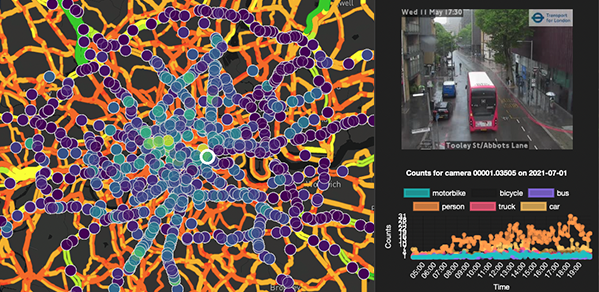
A monitoring tool, developed and deployed in London during the COVID-19 pandemic, has demonstrated how computer vision and machine learning techniques may benefit public health – after actively informing more than 700 social distancing interventions at the height of the pandemic’s first wave.
The Cambridge Engineering students that joined The Turing team made some important innovative contributions to the overall system that was deployed, ensuring its efficient operation.
Professor Mark Girolami
Researchers from the Universities of Cambridge and Warwick, together with The Alan Turing Institute, developed, deployed and delivered the tool to the Greater London Authority (GLA) and Transport for London (TfL), providing near real-time data of social distancing adherence on the streets of London. This ran over an 18-month period, including during the first two lockdowns in 2020, and the third lockdown in 2021.
The tool – driven by Digital Twins (realistic digital representations of physical assets), computing and data infrastructure, as well as state-of-the-art machine learning algorithms – helped to inform policy decision-making such as the effectiveness of the two-metre COVID-19 rule, and quickly identified where street spacing interventions were needed. These interventions included moving bus stops, widening pavements and closing parking bays to enable social distancing. The findings are reported in The Computer Journal.
Known as Project Odysseus, the researchers processed live feeds from more than 900 traffic cameras in order to monitor vehicle and pedestrian activity, while algorithms calculated the distances between pedestrians. The use of low-resolution footage ensured that no individuals were identifiable. The project repurposed air pollution tools and datasets from an earlier study by The Alan Turing Institute on air quality monitoring, and extended this monitoring to pedestrian activity as well as vehicles.
Project Odysseus successfully delivered these activity metrics via an online interface for convenient use by the policymakers. Through the web application, which served as an ‘early warning system’, the policymakers could gain a near real-time perspective of the impact of their decisions in an easy-to-use format and adapt their actions accordingly.
Professor Mark Girolami, Chief Scientist at The Alan Turing Institute, is co-first author of the paper, and the Sir Kirby Laing Professor of Civil Engineering at Cambridge, where he holds the Royal Academy of Engineering Research Chair in Data-Centric Engineering (DCE). He is also the Academic Director for the Cambridge Centre for Smart Infrastructure and Construction (CSIC).
Professor Girolami was joined on the project by Cambridge Engineering alumni Andrew Wang and Mihai Ilas, who were undergraduates at the time, having secured internships supporting TfL in assessing social distancing compliance during the various lockdowns. Also involved in the project and its ongoing development are PhD students Yannis Zachos and James Walsh, who are both part of the EPSRC Centre for Doctoral Training in Future Infrastructure and Built Environment: Resilience in a Changing World (FIBE2).
Professor Girolami said: “During the pandemic lockdowns, The Alan Turing Institute provided daily intelligence reports to TfL and the GLA, which supported developing policies and assessed the effectiveness of these policies in ensuring social distancing across all London boroughs. The reports were based on the analysis of all street camera video feeds, which relied upon a number of sophisticated machine learning and computational statistical methods operating at scale. The Cambridge Engineering students that joined The Turing team made some important innovative contributions to the overall system that was deployed, ensuring its efficient operation.”
He added: “Future work on this project includes validating our early warning detection system, improving the Digital Twin overall accuracy, providing more human and machine teaming or ‘human-in-the loop’ recommendations (with high ease of use for policymakers) and continuing to provide transparent and interrogatable examples of machine learning applications.”
Reference:
James Walsh; Oluwafunmilola Kesa; Andrew Wang; Mihai Ilas; Patrick O’Hara; Oscar Giles; Neil Dhir; Mark Girolami; Theodoros Damoulas. ‘Near Real-Time Social Distance Estimation In London’. The Computer Journal (2023). DOI: 10.1093/comjnl/bxac160

